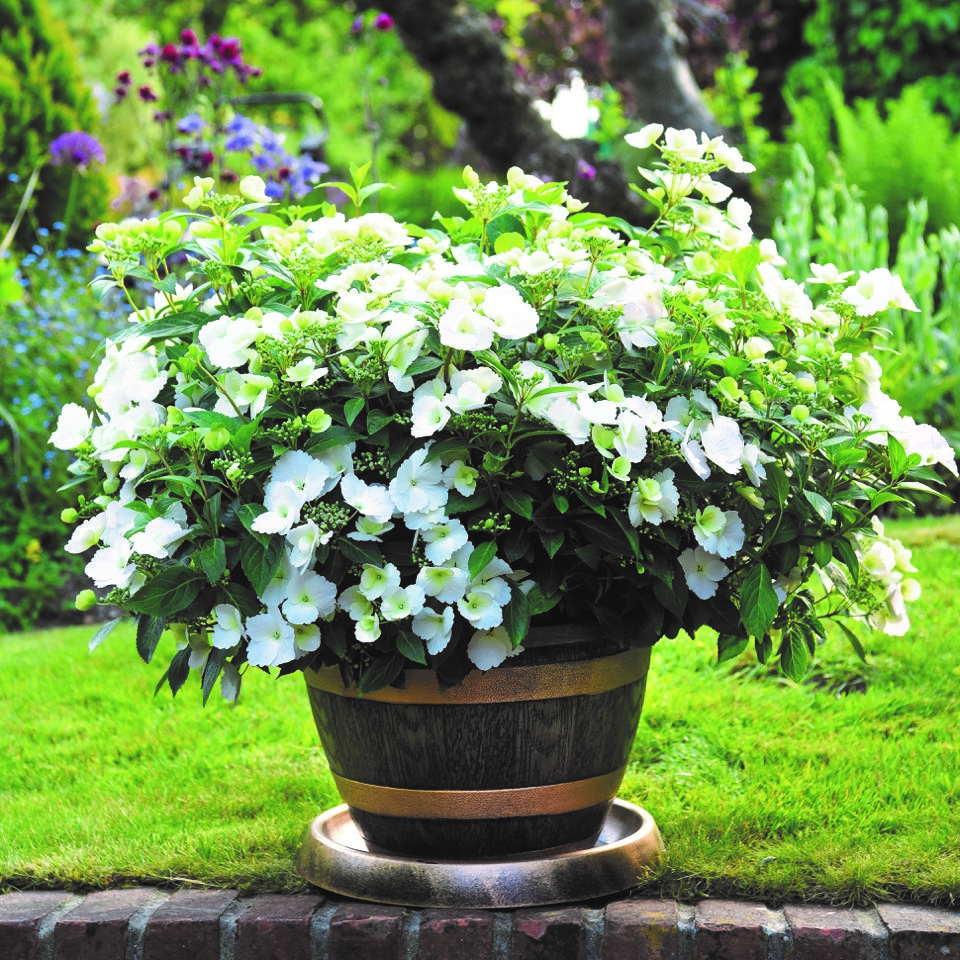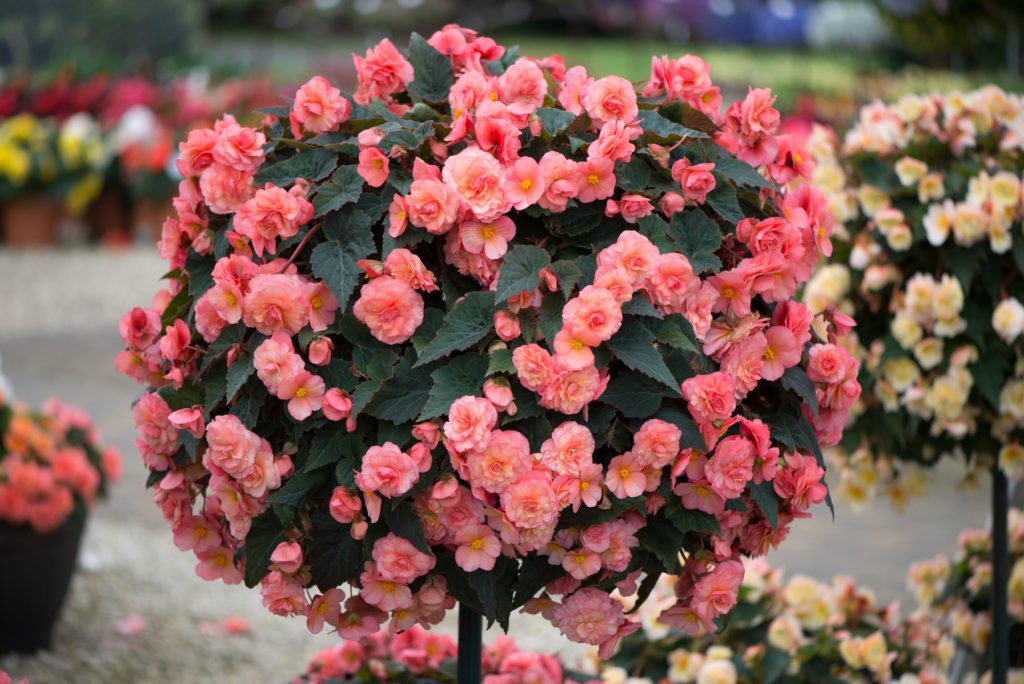
No, I’m not referring to clandestine comings and goings you understand. I’m talking about those shady corners in need of softening. All gardeners have them, including me, despite the fact that most of my garden is resolutely south-facing I still have some spots that get very little sun. One path, between the woodland borders, gets very shady by mid-April and there pots at either end. The sunnier end always has a single oak barrel containing tulips, because they last far longer in cool shade than they do in full sun. I avoid anything dark here because the flower disappears in shade, or over-bright and opt for the green and white elegance of ‘Spring Green’.
‘Spring Green’ is one of the most perennial and ‘willing to return’ tulips in border or pot, so my bulbs earn their keep and stay in the container for several years running. ‘Spring Green’ is an April-flowering viridiflora, so called because there are green virescent flames on the creamy white petals. There’s a newer, lily-flowered version named ‘Green Star’ and a double white named ‘Avant Garde’ and I do sometimes I plant these. Generally I go back to the classic ‘Spring Green’. There’s also a smattering of a March-flowering reticulate iris named ‘Harmony’ in that barrel, another great survivor. It provides flecks of blue.
The shadier end is more challenging, but I love ferns. The way the fronds unfurl (and they all do it in slightly different ways) is fascinating. The easiest ferns for pots in shade are named forms of Dryopteris, because most tolerate dry conditions as well as shade. The first 3 letters – dry – should remind you how good they are. Most Dryopteris hold their foliage until November and then the fronds get ragged. Cut the fading foliage away to reveal the brown knuckles, which make a winter feature in themselves. The fiddleneck crosiers unfurl to reveal their foliage, just as the bluebells turn cobalt-blue.
My favourite, for a pot, is Dryopteris filix-mas ‘Linearis Polydactila’. The leaves are minimalist, even if the name is not, and the lacy fronds expand over the edges of the pot. This fern produces clumps and the noses can be carefully separated and re-potted in early spring, although new divisions must be kept watered. Some of the smaller hydrangeas make excellent partners and I favour illuminating whites or greenish whites. My ultimate favourite is H. arboresecens ‘Hayes Sunburst’. And this is best grown in a pot, rather than in the garden, because the stems tend to be a little too spindly to support the wide heads of tiny, starry, double green-white flowers. They cascade over a pot very pleasingly, but would probably sprawl on the ground in the garden.
However all forms of drought tolerant H. arborescens work in pot, because they don’t demand copious amounts of water. H. arborsecens is an American species used to a Continental climate of hard winters and hot summers, so named forms are tough. It flowers on new wood and could be cut back, although I prefer to treat it like a fuchsia and cut it back to the highest shooting buds.

All hydrangeas make good potted plants for some shade. Just vary the pot size accordingly. H. paniculata ‘Kyushu’ ( a delicate white with pointed racemes rather than mopheads) would be good, or you could grow a new one named ‘Runaway Bride’. This is available from Suttons and T & M. This white lacecap hydrangea, which was the Chelsea Flower Show Plant of the Year in 2018, flowers from every leaf joint right through to September. The white flowers have a touch of pink to soften them, so it’s never stark or harsh. Avoid bright whites, they’re troublesome under summer sun.
I would always find room for the green form of the deciduous, hardy Japanese hakon Grass, Hakonechloa macra. This emerges in April and the soft all-green foliage curtsies over a tapering pot that I’ve had to relegate to this spot, to stop it blowing over in my windy garden. There is a named all-green form, ‘Nicolas’, that develops reddish tints in autumn and there are also golden variegations on offer. Hakon grass is a good border edging too., often planted to soften paths.
Or you could try wood millet, Melica uniflora f. albida. This is the daintiest, shade-loving grass of all and it will sprinkle rice-like, white beads through your ferns by May. Both of these grasses have had starring roles at every Chelsea Flower Show for twenty years, which says a lot. My ultimate companion is the curly wood sage, Teucrium scorodonia ‘Crispsum’. The pale-green, suede-textured foliage, among the most tactile in the plant world, has a ruffled edge that adds line and contrast.
I love texture and form and a couple of years ago I potted up an acid-loving fern with very leathery foliage. I can’t grow this primitive-looking fern in my neutral to alkaline soil. I potted up Blechnum spicant, often known as the native ladder fern, in ericaceous compost and it seems to have done well. I appreciate these leafy areas most when the weather is warm, because they’re as refreshing as chilled, home-made lemonade. That’s why Italian gardeners rely on so much soothing greenery, it brings down the blood pressure as temperatures rise.
You do need a bit of flower power in shade as well, but choices are limited. Begonias make perfect shade plants and there are some newly raised scented ones sold under the name Sweet Spice. They come in soft apricots, lemons and soft-orange, not in garish football-sized red and yellow. Sweet Spice has flowers that are a manageable size and there are plenty of them. The well-behaved matt foliage is pointed, with a red wavy edge that picks up the darker, less-showy female flowers. In begonias, it’s the males that have the frills and flounces: they’re the Beau Brummells. The ladies are rather plain Janes.

Begonias hail from South America and they are extremely frost-tender plants, so their soft stems and foliage cannot be exposed to the vagaries of British summertime (so called) until the first week of June. This is also true of dahlias, fuchsias and salvias. All four have evolved in the evenly balanced days found close the equator, when twelve hours of night are balanced by twelve hours of day. They are at their best here when days and nights are beginning to be evenly balanced. Plant breeders continue to work hard to raise earlier flowering plants, but they all have a tendency to flower more prolifically from August onwards. I find that a strength, now that autumns last longer due to climate change.
Begonias will carry on until the frost intervenes and you can extend them by fleecing on chilly nights. Sweet Spice series is micro-propagated from mother plants kept by the British breeders, so you will have to buy plugs initially. They will make tubers and these can be kept from year to year. There are lots of begonias on offer and they will all do well in shade. Some, like ‘Glowing Embers’ have sultry foliage. The species have evolved in moist subtropical and tropical climates under trees, so a shady spot in the garden is perfect.



